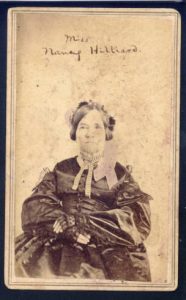
“Ann Segur Hilliard (1807-1873). Exhibit Women in the Early Years, Slide 05, Virtual Museum.” The Carolina Story: A Virtual Museum of University History, Southern Historical Collection, Wilson Library, University of North Carolina at Chapel Hill. [1]
Ann Segur Hilliard (1807-1873)
This portrait photograph of Ann Segur Hilliard, or “Miss Nancy” to the many people that knew her, is a part of The Carolina Story: A Virtual Museum of University History at the UNC library. Hilliard’s portrait could be of value to a historian investigating food ways in Chapel Hill because of the important role Hilliard played in the Chapel Hill community, for both the university’s students, and residents of the town. Although her role was not as a professor, she played an essential part in the lives of many students as one of the major food providers near campus. She opened the doors to the popular Eagle Hotel, and later to her own home in order to cater to residents and travelers with soulful food once described as being too good to be a part of a college student diet [2]. For these reasons, she can be characterized as an essential part of the Chapel Hill food story.
Hilliard’s Eagle Hotel, that once stood where Graham Memorial is now located, accommodated mainly students attending UNC, but also housed a number of outside visitors. During meal time hours, Hilliard’s hotel served as many as 150 people at a time [3]. Over Hilliard’s many years in the hotel industry she, and her hotel, became a well-loved and popular staple of Chapel Hill. With the numerous visitors coming year-round, the Eagle Hotel became the hotel of Chapel Hill earning a reputation for her genuine hospitality and outstanding cuisine. The Eagle’s popularity even reached the President of the United States at the time and UNC alumni, James K. Polk, who decided to stay at the hotel when visiting Chapel Hill [3].
Helping UNC students in any way possible, was a great passion of Hilliard. So much so, she was known for sometimes waiving the bill of students unable to pay for their food or board [4]. It was this devotion that drove her to continue her role of providing the students of UNC bountiful meals, even after she sold her hotel in 1857. Rather than serving the food in a dining hall as she had previously done, she hosted people in the basement of her home that she dubbed The Crystal Palace [4].
In conclusion, Hilliard played a principal role in keeping the students and guests of Chapel Hill coming back for more with her generous personality, abundant meals, and warm hospitality. The Chapel Hill food story would be incomplete without her love of cooking and dedication to helping students, which made a lasting impact on the community.
[1] “Ann Segur Hilliard (1807-1873) : Virtual Museum.” The Carolina Story: A Virtual Museum of University History. Accessed October 03, 2018. https://dc.lib.unc.edu/cdm/ref/collection/vir_museum/id/346.
[2] Macfie, John. “Hilliard, “Nancy” Ann Segur.” NCpedia. January 1, 1988. Accessed October 02, 2018. https://www.ncpedia.org/biography/hilliard-nancy-ann-segur.
[3] Davis, R.P. Stephen, Jr. “The Hidden Campus: Archaeological Glimpses of UNC in the …” The Hidden Campus: Archaeological Glimpses of UNC in the Nineteenth Century. 2015. Accessed October 2, 2018. https://blogs.lib.unc.edu/news/index.php/2015/03/hidden-campus-exhibit/.
[4] Skowronek, Russell K., and Kenneth E. Lewis, eds. Beneath the Ivory Tower: The Archaeology of Academia. University Press of Florida, 2010. Florida Scholarship Online, 2011. doi: 10.5744/florida/9780813034225.001.0001.
-Gwyneth Gassaway